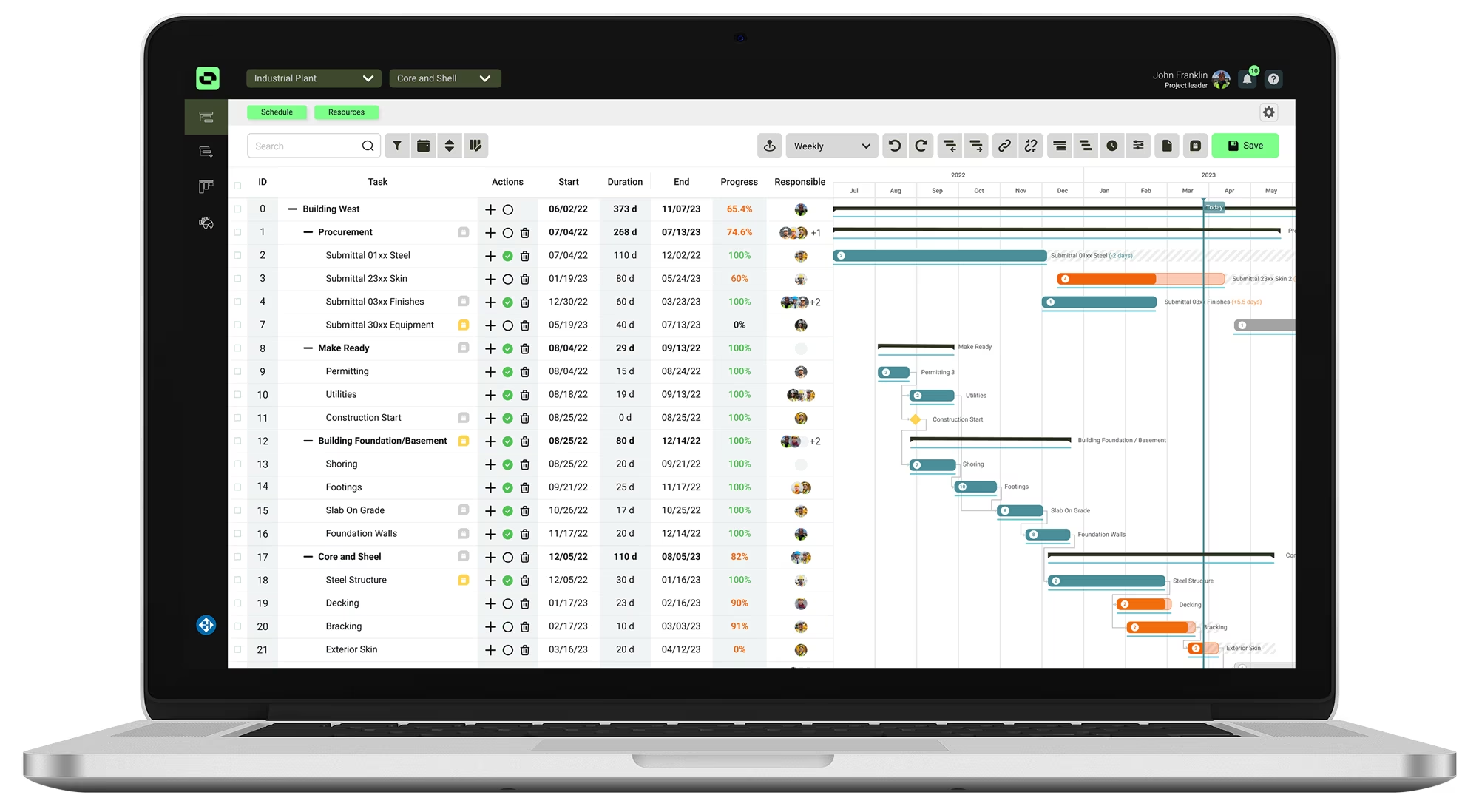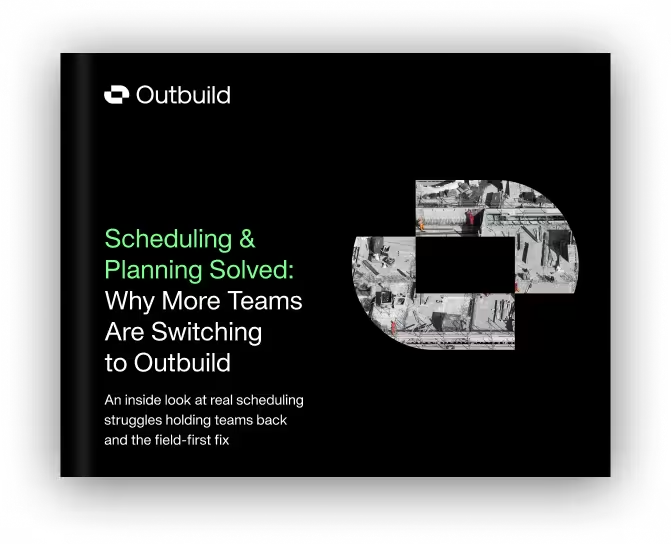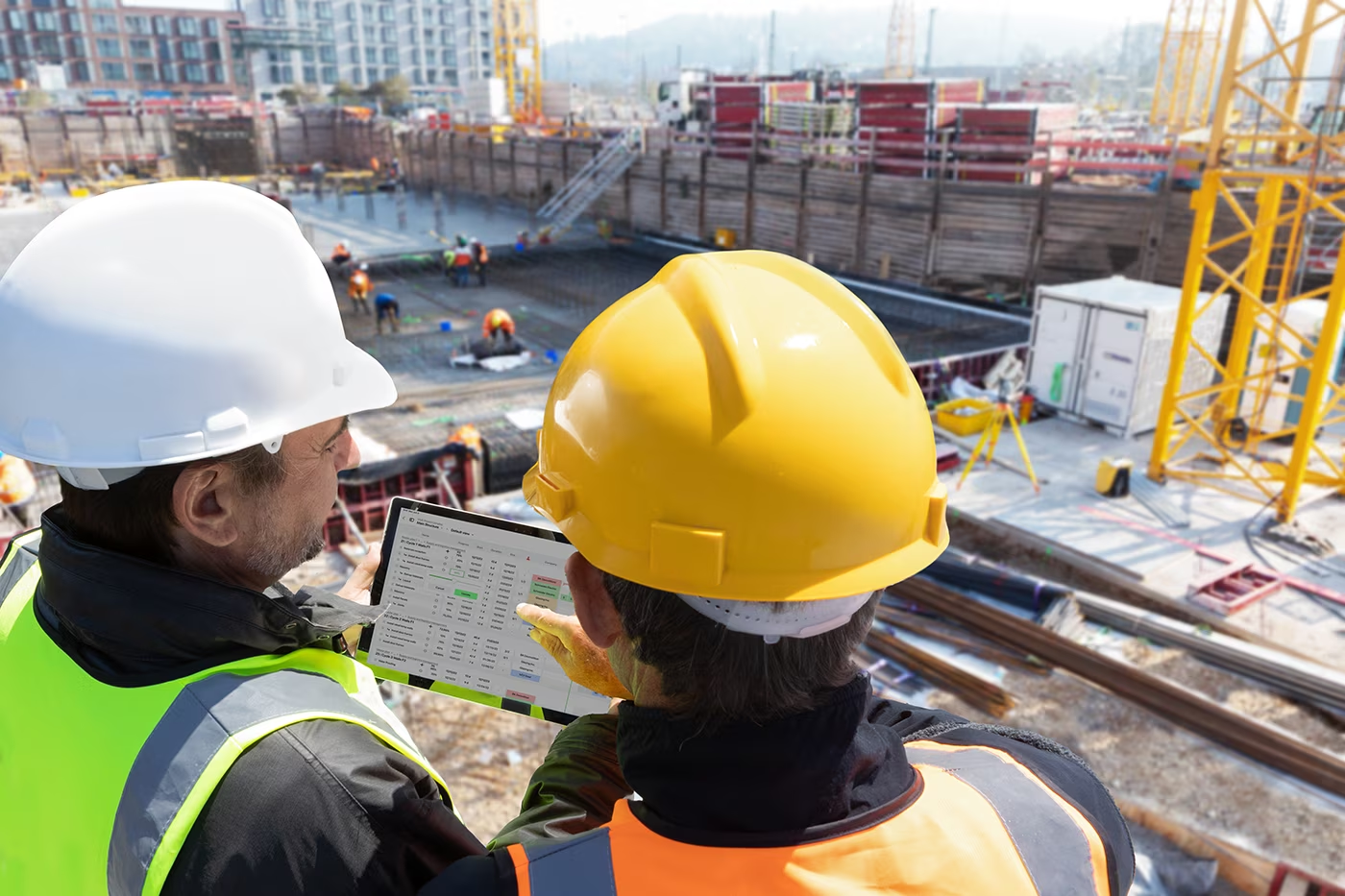Outbuild is online scheduling software to work together on connected project schedules and look-aheads, enabling everyone to move faster.
Key Takeaways
Table of contents
- Preconstruction Importance
- Roles & Pre Construction Responsibilities
- What is a preconstruction meeting?
- The work itself: what happens in preconstruction?
- Preconstruction Tech for the Field and the Office
- Pre Construction Activities List
- Common Preconstruction Pitfalls to Avoid
- An Example of Pre-Construction Planning:
- Kicking off Pre Construction Planning
What Is Pre Construction? Preconstruction is the planning work you do before anyone sets foot on site. It turns an idea into a buildable plan with a clear budget, schedule, and risk plan. If you skip it, you pay for it later in change orders, delays, and friction. If you do it well, the job runs cleaner and you keep control.
To break it down further:
- Pre-construction definition: everything from early design and pricing to permits, contracting, and site prep
- If you’ve wondered what does preconstruction mean, it means aligning scope, cost, time, and risk so the build can start without surprises.
- Another way to define pre construction: it’s the handoff between “we think we know” and “we’re ready to build.”
Check out the video below for a high level of pre construction meaning.
Now that we understand the definition of pre-construction, let's discuss its importance.
Bad drawings, fuzzy scope, shaky budgets, and missed approvals don’t magically fix themselves during construction. They grow. Strong preconstruction keeps you out of that spiral by:
- Locking scope before you buy out work
- Surfacing risks while you still have options
- Setting a realistic pre construction timeline with float where you truly need it
- Aligning stakeholders so your first day on site isn’t chaos
If you want the bottom line: the better your preconstruction planning, the fewer fires you’ll fight later.
Owner/Developer: Defines success criteria, funding, and timing; approve scope and cost moves; align tenant needs.
Design Team: delivers coordinated drawings and specs; resolve clashes; support permitting; clarify performance intent.
GC/CM: leads the estimate, schedule, buyout strategy, risk planning and logistics
Subcontractors/Trade Partners: advise on methods, lead times, and field realities and commit to staffing and sequencing.
Usually there is a preconstruction team or a preconstruction manager from the general contractor that leads the preconstruction stage of a project.
What is a preconstruction manager and what does a preconstruction manager do? In short: they oversee scope, cost, schedule and risk before a shovel even hits the ground. They are in charge of estimates, lead value and risk reviews, align the pre construction plan, and prep the handoff to operations.
Additional Stakeholders can include legal, permitting authorities, utilities, environmental consultants, and sometimes community representatives. Bring them in early; surprises later are expensive.

A preconstruction meeting is a great way to level expectations early on in a project. During the meeting, roles, deliverables and decision cadence become apparent.
A preconstruction meeting often goes over:
- Important goals of the Owner/Developer
- who signs off on what, and when
- Milestones and long-lead items
- Top risks identified early (supply chain, weather, utilities) and how they’ll be monitored.
- how you’ll manage design changes and scope clarifications
- the baseline budget, alternates, and contingency rules
- the path for RFIs, submittals, and permits
- site access, safety expectations, and neighbor constraints
Pro Tip: Run a shorter follow-up preconstruction meeting after major design updates. Keep the loop tight so small gaps don’t become big issues.
The below is the heart of the preconstruction process and is a practical flow most teams follow. (Order may shift based on delivery method, but the pieces are the same in this pre construction activities list:
Design and Development
Move from concept to coordinated construction documents (CDs). Test design options with cost and schedule in mind. Use model walk-throughs to catch conflicts early. Get clarity on performance criteria—like energy use, acoustics, and tolerances—before you lock in pricing.
Bidding
Start with rough order-of-magnitude (ROM) estimates and build detail progressively. Track all assumptions. Separate must-haves from nice-to-haves. Hold value engineering sessions focused on function, not just cost-cutting. Treat alternates like switches you can turn on or off—not chaos you bolt on at the last minute.
Use RFQs and RFPs to find the right team for the job, not just the lowest bid. Compare proposals apples-to-apples. Look closely at staffing plans, safety records, and experience with similar projects. Know which items are negotiable and which aren’t.
Risk Preparation & Mitigation
List the top 10 risks you actually fear; like supply chain issues for long-lead equipment, soil conditions, tie-ins, winter weather, utility approvals, or community constraints.
For each risk:
- Avoid it, reduce it, transfer it, or accept it
- Assign a clear owner and set a trigger point for action
- Make contingency funds visible and transparent, not hidden in a “black box”
Project Schedule and Planning
Lay out a preliminary construction schedule and identify key milestones, dependencies, and potential roadblocks early.
- Define what “on time” means for the project—substantial completion, occupancy, or another milestone.
- Align design deliverables, procurement, and permitting with construction start dates.
- Build flexibility into your schedule to absorb surprises without derailing the entire job.
- Create the schedule with both the office and field teams to ensure it’s realistic.
A pre construction schedule is more than a Gantt printout. It’s your promise to the project. Here’s how to build one people trust:
- Start with the big rocks: approvals, design milestones, buyout, long-lead items, and enabling work.
- Break work into pre construction schedule activities that match how crews install, not how org charts look.
- Identify the critical path and protect it. Add buffers where risk is real, not everywhere.
- Share logic, not just dates, so everyone sees why the sequence matters.
Permitting and Approvals
Start pre-application meetings early to avoid surprises later. Coordinate submittal sets and review cycles with your project milestones.
Treat each permit like a critical procurement item: track deadlines, follow-ups, and approvals closely.
Mobilization and Early Site Needs
Plan for the basics that keep your site running smoothly: laydown areas, logistics, temporary power, water, and office space.
Consider fence routes, delivery hours, and neighborhood requirements. Confirm field leadership before the first crew arrives.
If mobilization is sloppy, your first month on site will be too.
When it comes to pre-construction software, there are several strong options depending on your team’s needs.
- Procore offers a suite for construction management with modules that cover estimating, bidding, and design collaboration.
- DESTINI by Beck Technology is great for early cost modeling and conceptual estimating.
- Buildr unifies many preconstruction tasks into one platform and is known for being a great pre-construction planner
Which preconstruction software is the best? The greatest choice comes down to what matters most for your process.
Look for preconstruction software that integrates estimating and takeoff smoothly, simplifies bid management, and provides clear design and cost modeling tools.
Consider how well the platform connects with your other systems, how easy it is for your team to learn, and whether the pricing fits your budget.
The project timeline is an important part of the planning process and should be considered a must-have when considering technology.
Pairing your preconstruction and construction management software with scheduling and planning software like Outbuild is essential because it bridges the gap between planning and execution, ensuring schedules stay accurate, connected, and ready for the field the moment work begins.
Run your next project like a pro with this pre construction activities list below. In fact, load these activities into Outbuild to keep every step clear, organized, and on track from day one.
Scope & Design
- Owner criteria defined
- Systems chosen and documented
- Specs coordinated across trades
- Open design decisions scheduled
Money
- Estimate at current design level
- Alternates and allowances listed
- Contingency rules set
- Cost exposure log maintained
Risk Management
- Top 10 risks with owners and triggers
- Avoid/mitigate/transfer/accept marked
- Early tests or pilot work planned
- Weather and community constraints addressed
Schedule
- Milestones and critical path identified
- Long-lead tracking started
- Buyout phasing mapped
- Field-ready sequence reviewed by supers

Permits & Approvals
- Pre-app meetings complete
- Submittals aligned to milestones
- Inspections and UT coordination slotted
- Special conditions captured (noise, hours, access)
Mobilization
- Site logistics and fencing plan
- Temp power/water/data plan
- Office, laydown, and deliveries routes set
- Safety plan tailored to site
Handoff
- Ops kickoff held
- Data flows set (estimate→buyout, model→coord)
- Baseline schedule issued and signed
Decision log and contacts posted
- Moving targets: if scope is still changing, slow down and decide. “We’ll figure it out later” turns into change orders.
- Shiny objects: a cheaper alternative is not a win if it adds risk or delays procurement.
- Ghost float: fake buffers make everyone feel good until they vanish. Use real logic and protect it.
- Meeting sprawl: keep your cadence tight and purposeful. Short agendas. Decisions tracked. Owners assigned.

A general contractor was gearing up to build a 500,000-square-foot warehouse for a major retailer. They spent valuable time upfront creating a rock solid pre-construction plan.
- Walking the site to identify soil issues and potential utility conflicts.
- Working with designers to refine the plans, catching clashes before they reached the field.
- Building a realistic schedule with input from superintendents and trade partners.
- Setting clear budgets and contingencies so there were no surprises when materials costs shifted.
- Mapping out risks like supply chain delays and weather impacts, with backup plans ready to go.
By doing the hard work early, the project team avoided costly delays later. When the first crews mobilized, everyone knew exactly what needed to happen and when—and they finished the warehouse three weeks early. This is a great pre-construction schedule example.
- Hold the kickoff and publish a simple plan: who decides what, when.
- Build a baseline schedule that crews believe, then protect it.
- Keep risk visible and assign owners.
- Use Outbuild to connect planning to weekly work.
- Transition from preconstuction to construction with a clean handoff: scope, money, timeline, risk all aligned
Getting started with your project preconstruction checklist is easy with Outbuild. Start your 14-day free trial today or book a demo to begin.
Run your next project like a pro with this pre construction activities list below. In fact, load these activities into Outbuild to keep every step clear, organized, and on track from day one.
Scope & Design
- Owner criteria defined
- Systems chosen and documented
- Specs coordinated across trades
- Open design decisions scheduled
Money
- Estimate at current design level
- Alternates and allowances listed
- Contingency rules set
- Cost exposure log maintained
Risk Management
- Top 10 risks with owners and triggers
- Avoid/mitigate/transfer/accept marked
- Early tests or pilot work planned
- Weather and community constraints addressed
Schedule
- Milestones and critical path identified
- Long-lead tracking started
- Buyout phasing mapped
- Field-ready sequence reviewed by supers

Permits & Approvals
- Pre-app meetings complete
- Submittals aligned to milestones
- Inspections and UT coordination slotted
- Special conditions captured (noise, hours, access)
Mobilization
- Site logistics and fencing plan
- Temp power/water/data plan
- Office, laydown, and deliveries routes set
- Safety plan tailored to site
Handoff
- Ops kickoff held
- Data flows set (estimate→buyout, model→coord)
- Baseline schedule issued and signed
Decision log and contacts posted
- Moving targets: if scope is still changing, slow down and decide. “We’ll figure it out later” turns into change orders.
- Shiny objects: a cheaper alternative is not a win if it adds risk or delays procurement.
- Ghost float: fake buffers make everyone feel good until they vanish. Use real logic and protect it.
- Meeting sprawl: keep your cadence tight and purposeful. Short agendas. Decisions tracked. Owners assigned.

A general contractor was gearing up to build a 500,000-square-foot warehouse for a major retailer. They spent valuable time upfront creating a rock solid pre-construction plan.
- Walking the site to identify soil issues and potential utility conflicts.
- Working with designers to refine the plans, catching clashes before they reached the field.
- Building a realistic schedule with input from superintendents and trade partners.
- Setting clear budgets and contingencies so there were no surprises when materials costs shifted.
- Mapping out risks like supply chain delays and weather impacts, with backup plans ready to go.
By doing the hard work early, the project team avoided costly delays later. When the first crews mobilized, everyone knew exactly what needed to happen and when—and they finished the warehouse three weeks early. This is a great pre-construction schedule example.
- Hold the kickoff and publish a simple plan: who decides what, when.
- Build a baseline schedule that crews believe, then protect it.
- Keep risk visible and assign owners.
- Use Outbuild to connect planning to weekly work.
- Transition from preconstuction to construction with a clean handoff: scope, money, timeline, risk all aligned
Getting started with your project preconstruction checklist is easy with Outbuild. Start your 14-day free trial today or book a demo to begin.
Frequently Asked Questions
Preconstruction services usually include milestone estimating, reviews of constructability and logistics, and value analysis. They also cover risk planning, procurement, and tracking long-lead items. Other tasks are coordinating permits, scheduling baselines, planning site safety, communicating with stakeholders, and handing off to operations. As a GC, it’s helpful to provide owners and developers with a preconstruction services list.
Preconstruction software helps construction teams plan everything before building begins. It combines estimating, bidding, scheduling, and risk planning in one place. This way, evPreconstruction software helps construction teams plan everything before building begins. It combines estimating, bidding, scheduling, and risk planning in one place. This way, everyone uses the same current information. By keeping budgets, timelines, and designs clear and connected, it helps prevent costly surprises once work starts on site.eryone uses the same current information. By keeping budgets, timelines, and designs clear and connected, it helps prevent costly surprises once work starts on site.
A preconstruction manager oversees everything within construction pre planning. They coordinate budgets, schedules, designs, and bids to make sure the project is realistic and ready to build. Their job is to catch problems early, keep teams aligned, and set the project up for a smooth start.
Pretask plan management is making a clear plan before starting a specific task on a jobsite. This type of preliminary planning in construction helps crews understand what needs to be done, the safest way to do it, and who’s responsible. This keeps work organized, reduces mistakes, and lowers the chance of accidents.
Related Articles
Ready to see Outbuild?
Join hundreds of contractors from 10+ countries that are saving money by scheduling better










